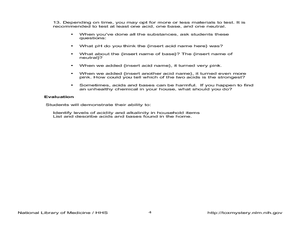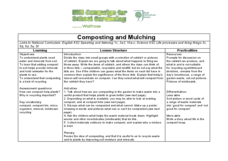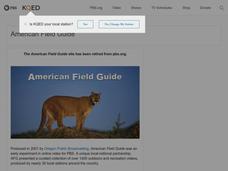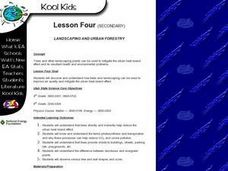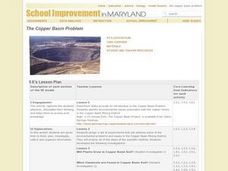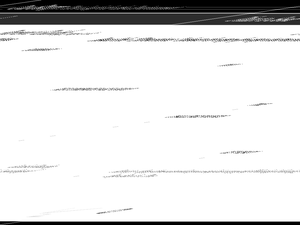Curated OER
Acid or Base? Toxie's on the Case
Students recognize the difference between acids and bases. In this ToxMystery instructional activity, students play a computer game and experiment to find the difference between acids and bases. Students use litmus paper to...
Curated OER
Composting and Mulching
Second graders define composting and recognize what can be composted. In this composting and mulching lesson, 2nd graders classify objects or pictures as good or bad for composting. Students write a story about life in the compost...
Curated OER
Eco-Detectives
Students explore natural decomposers. In this decomposing lesson, students participate in a WebQuest to discover how nature handles decomposition. Students compare natural methods for decomposition with recycling efforts.
Curated OER
The Formation and Value of Temperate Grasslands
Students get an overview of the climate and organisms of the North American Prairie. After a lecture, and watching some videos imbedded in this plan, students compile research data on the North American Prairie.
Curated OER
Where Does Food Come From?
Learners recognize that food we eat comes from farms. In this where does food come from lesson, students discuss planting crops and how they grow. Learners plant seeds for edible crops and eat them when are ripe. Students...
Curated OER
Acid Rain
Students understand the dynamics of acid rain and its impact on the living and non-living environment. They hypothesize how acid rain affects water pH levels in two lake systems with differing watershed features.
Curated OER
Funky Fungus
Learners discuss decomposition, bacteria, fungi and other microscopic organisms. They participate in an experiment to grow fungus on bread. As the fungus colonies grow, students observe them under a microscope to identify and locate...
Curated OER
Our Friends or Foes
In this living organisms worksheet, 6th graders choose the multiple choice answer to 10 questions. Students then read and answer 10 statements as true or false and fill in the blanks to 5 statements.
Curated OER
How Much is Dirt Worth?
Fourth graders graph the percentages of the materials that make up the Earth and complete computations based on their results. In this topsoil lesson, 4th graders diagram the different layers of Earth's composition.
Curated OER
Life in a Cup
Third graders make and maintain a mini terrarium. They keep a daily journal of what happens in their terrarium and record daily observations and measurements.
Curated OER
Web of Life - Role-Playing
Students role-play how organisms adapt to their environment. They play 20 questions with plant and animal habitats. They create a web of life to demonstrate how each plant and animal relies on the other for survival.
Curated OER
Landscaping And Urban Forestry - Lesson 4 (Grades 8-9)
Students discuss reasons to plant trees and the best locations for cooling. They study two homes and identify types and locations of trees and determine the placement of the central air conditioners. The class plans a landscape design...
Curated OER
The Discovery of Photosynthesis
Students explore how scientists discover photosynthesis. In this biology lesson plan, students identify the basic requirements for photosynthesis to happen. They recreate past scientists' experiments and record their observations.
Curated OER
Food Chains
Fourth graders study food chains, producers, consumers, and decomposers. They play a food chain game and create food chain mobiles or posters. They take a nature hike around the school and observe various parts of a food chain.
Curated OER
Parts of the Seed
In this biology worksheet, students read about the parts of plant seeds and look at a seed diagram. They read about the roots, endosperm, embryo, and the process of germination. They answer 8 online multiple choice questions based on the...
Curated OER
The Copper Basin Problem
Learners view a video about how human actions impact the environment. They design a set of experiments to address some of the problems and issues raised by the video.
Curated OER
An Erosion Survey
In this erosion worksheet, learners draw a map of their school ground or neighborhood, mark examples of weathering and erosion, and list the examples on spaces provided. A chart with examples of different types of weathering and erosion...
Curated OER
Amazing Grazing: Keeping Our Ecosystem Running
Students discover the value of sustainability within our ecosystem. In this ecological instructional activity, students discuss the importance of a food cycle in our society, and how humans can improve the conservation of a healthy...
Curated OER
"Web of Life" Game
Students relate members of an ecosystem by their interactions. In this ecosystem lesson, students toss a ball to other members of their group (each representing a member of an ecosystem) and tell how they are related to that member....
Curated OER
Three Clouds Activity
Students understand how clouds are formed. In this cloud activity, students participate in three experiments to make clouds. Students complete activity sheets for each experiment.
Curated OER
Carbon Cycle Game
In this carbon cycle lesson, middle schoolers review the carbon cycle and visit stations in the room where they experience every phase in the carbon cycle. Students journal about their journey through the cycle and brainstorm ways...
Curated OER
Photosynthesis Explored
Students observe the production of gas as an effect of photosynthesis. In this biology lesson, students perform an experiment with pondweed and make measurements and predictions about photosynthesis and the plant.
Curated OER
Plant a Seed
Young scholars complete a seed and plant growth activity. In this plant growth lesson, students read about Lady Bird Johnson and then answer questions about her role in the beautification and the environment. Young scholars participate...
Curated OER
Friction
Learners explore friction as a force that slows moving objects, explain conclusions in terms of the roughness or smoothness of surfaces, relate results to predictions, and begin to know how to plan a fair test.
